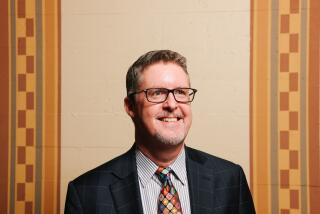Adventists, Soviets Negotiate to Build Joint Printing Plant
- Share via
The Seventh-day Adventist Church is “seriously negotiating” with the Soviet Union to build a joint religious publishing plant in that country, according to the Washington-based denomination.
“They would probably provide the land and building and we will probably place the equipment there,” said Shirley Burton, Adventist news director.
If accomplished, the unparalleled arrangement would represent a major achievement for a Western church body seeking to benefit from slowly improving opportunities for religious expression in the Soviet Union.
But it would be all the more so for the growing but relatively low-profile Seventh-day Adventists. Though it has 5.2 million members worldwide, the church (700,000 U.S. members) is distinguished from the rest of conservative Protestantism mainly by its emphasis on health services and vegetarianism and a zeal for religious liberty arising principally out of its adherence to Saturday as a day of rest. The church was founded in the 19th Century.
Use by Government
Initial discussions have conceived the publishing house as serving more than the small Adventist church membership of 32,000 in the Soviet Union. The government would use the presses for other religious publishing and as much as 50% of the time for their own commercial publishing, Burton said in a telephone interview.
“Nothing has been agreed upon yet,” Burton added. She said she was told Wednesday by the Rev. Mikhail P. Kulakov, president of the Assn. of Seventh-day Adventists in the Soviet Union, that the Communist Party’s Central Committee is still weighing the possibility.
Kulakov will be receiving an honorary doctorate today from Southwestern Adventist College in Keene, Tex., where he will also deliver the baccalaureate address.
That gesture illustrates the cordial relations already developed between Soviet and Adventist leaders, resulting in:
- Permission, received this year, to print 13,000 Bibles in Russian and 2,000 in Ukrainian for distribution in the Soviet Union.
- Building of a three-story Adventist seminary, apartment complex and church office in Tula, about 75 miles southwest of Moscow. Construction is expected to be completed by August, but education of 16 students is already under way.
- A magazine examining Adventist church life in the Soviet Union and the United States that was translated into Russian and printed in 30,000 copies last year.
Publication of the 36-page, full-color magazine followed the visit in October, 1986, of Konstantin Kharchev, chairman of the U.S.S.R. Council on Religious Affairs, to the Adventists’ Review and Herald Publishing Assn. in Hagerstown, Md.
Facilities Toured
Kharchev and Kulakov, accompanied by Adventist World President Neal Wilson, visited Adventist college campuses, hospitals and other facilities in Southern California last September.
At Loma Linda University, Kharchev described his work as “protecting the rights of all religious factions in our country and seeing that regardless of size and influence all are treated fairly.”
In the Soviet Union, he said, “we do not speak of people as atheists, Christians, Jews, Hindus, or things like that. There are either ‘believers’ who believe in something which satisfies their inner or spiritual needs, or ‘nonbelievers’ who are atheists.”
Speaking optimistically of changes in church-state relationships under Soviet leader Mikhail S. Gorbachev, Kharchev said he would quit the post he has held since 1984 if relations between church and state in his country do not improve.
Caution Expressed
Some American Adventists, however, have expressed caution over the prospect of a joint Adventist-U.S.S.R. printing plant.
An editorial in the current issue of Spectrum, an independent journal, said it would be “morally grotesque” if the church commits itself to such an agreement without insisting that the Soviet government free from jail 11 “prisoners of conscience” who call themselves True and Free Adventists but are not members of the government-recognized Seventh-day Adventists.
Spectrum Editor Roy Branson, who is also a senior research fellow at the Kennedy Institute of Ethics, complimented Wilson, the Seventh-day Adventist president, for issuing a written plea last year in Moscow calling for the Soviet release of all “prisoners of conscience” by May 1, 1988, in connection with the observances of 1,000 years of Christianity in Russia.
Responsibility to Prisoners
But Branson added, “It would seem that Adventists have a special responsibility to work on behalf of prisoners of conscience who are fellow Sabbath-keeping Adventists--whether or not they belong to groups recognized by the Soviet government.”
U.S. Adventist leaders, however, are not making the release of the Soviet Adventists a condition for the agreement, said Burton, the church headquarters’ spokeswoman. “Some of those 11 are already out of prison, according to Kulakov,” she said. The Soviet Adventist leader, once imprisoned himself, also told Burton that no Seventh-day Adventist is in prison today.
Burton acknowledged that some Adventists have questioned whether it is advisable for the church to be so closely tied to the Soviet state.
In that vein, Branson cautioned that “as Adventist leaders enjoy an increasing intimacy with the Soviet government, they may become reluctant to struggle against government interference if it risks losing the denomination’s new-found privileges.”
Spectrum magazine reported that the Soviet Union would own 51% of the plant, receiving that share of the profits, and that a Soviet government official would be the board chairman. But Burton said those matters have not yet been decided.
More to Read
Sign up for Essential California
The most important California stories and recommendations in your inbox every morning.
You may occasionally receive promotional content from the Los Angeles Times.










